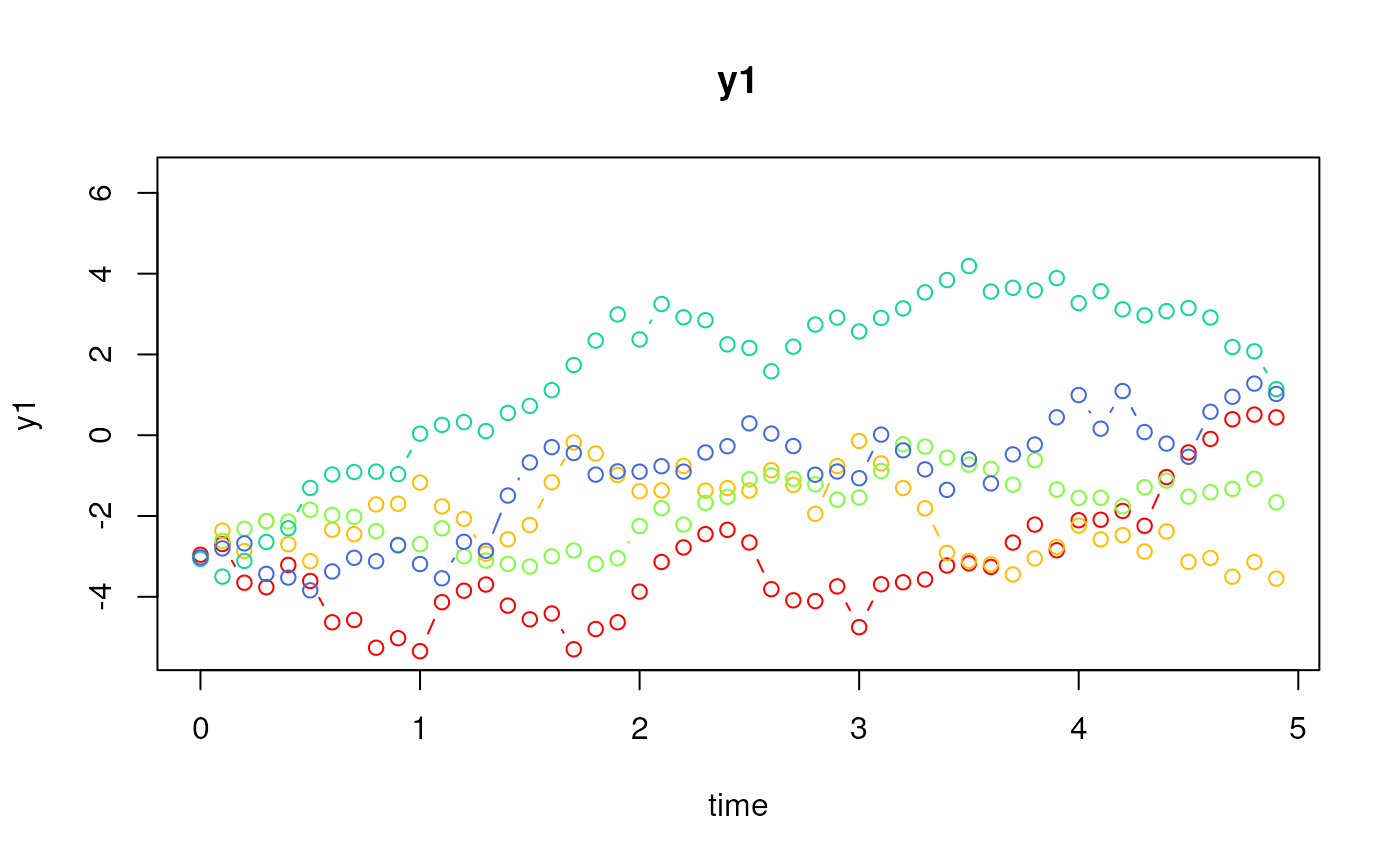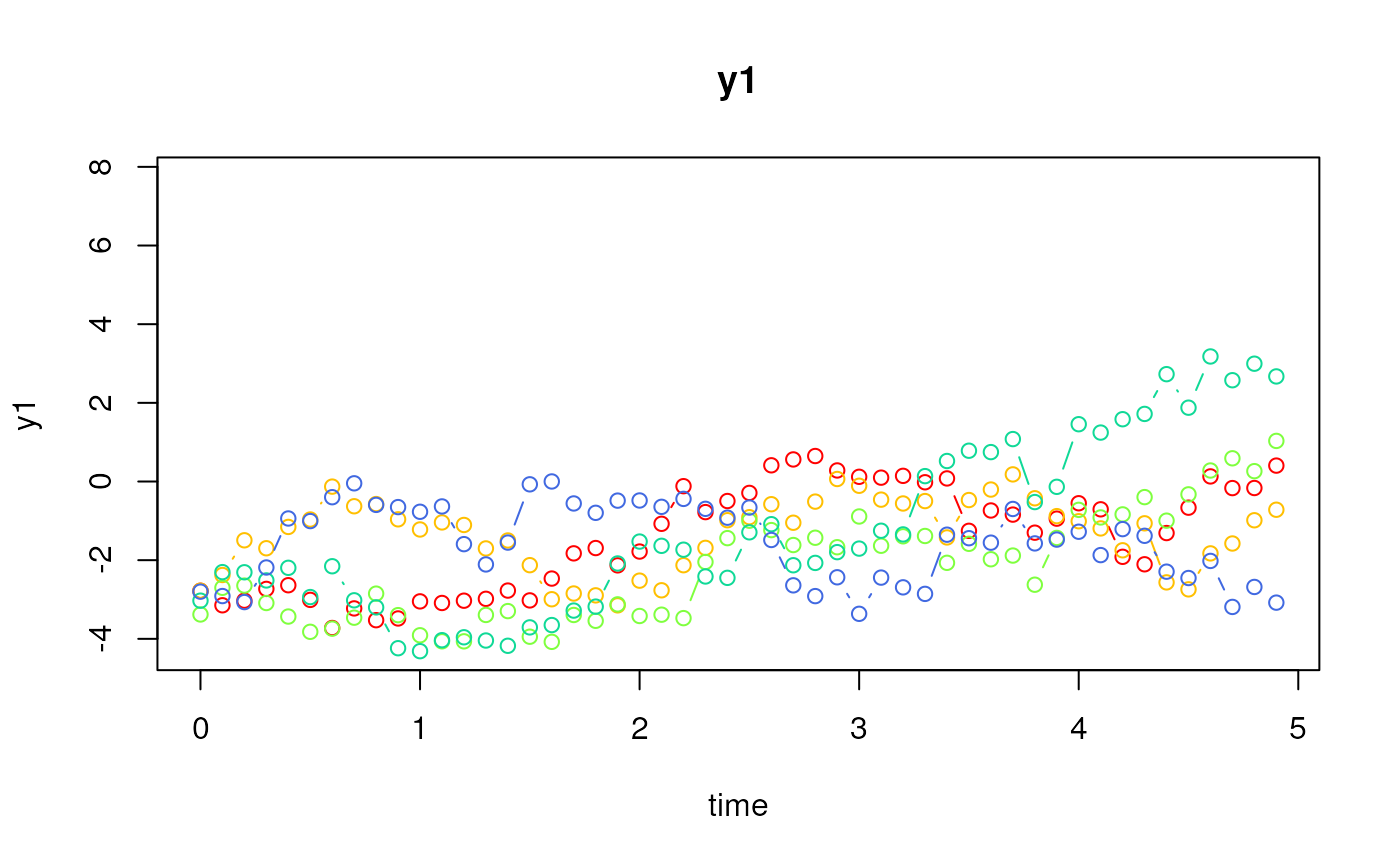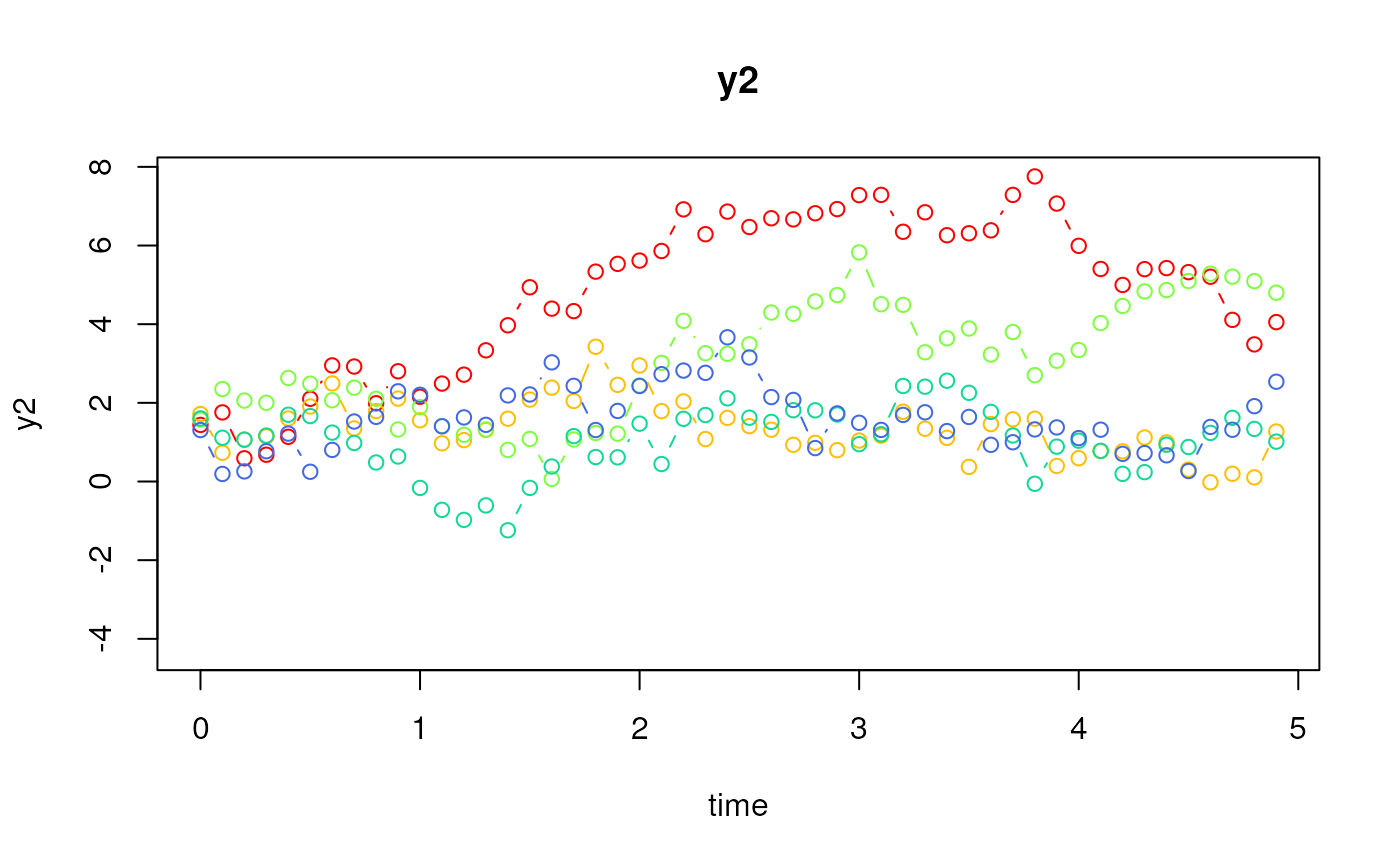Simulate Data from the Linear Stochastic Differential Equation Model using a State Space Model Parameterization (Individual-Varying Parameters)
Source:R/simStateSpace-sim-ssm-lin-sde-i-vary.R
SimSSMLinSDEIVary.RdThis function simulates data from the linear stochastic differential equation model using a state space model parameterization. It assumes that the parameters can vary across individuals.
Usage
SimSSMLinSDEIVary(
n,
time,
delta_t = 1,
mu0,
sigma0_l,
iota,
phi,
sigma_l,
nu,
lambda,
theta_l,
type = 0,
x = NULL,
gamma = NULL,
kappa = NULL
)Arguments
- n
Positive integer. Number of individuals.
- time
Positive integer. Number of time points.
- delta_t
Numeric. Time interval. The default value is
1.0with an option to use a numeric value for the discretized state space model parameterization of the linear stochastic differential equation model.- mu0
List of numeric vectors. Each element of the list is the mean of initial latent variable values (\(\boldsymbol{\mu}_{\boldsymbol{\eta} \mid 0}\)).
- sigma0_l
List of numeric matrices. Each element of the list is the Cholesky factorization (
t(chol(sigma0))) of the covariance matrix of initial latent variable values (\(\boldsymbol{\Sigma}_{\boldsymbol{\eta} \mid 0}\)).- iota
List of numeric vectors. Each element of the list is an unobserved term that is constant over time (\(\boldsymbol{\iota}\)).
- phi
List of numeric matrix. Each element of the list is the drift matrix which represents the rate of change of the solution in the absence of any random fluctuations (\(\boldsymbol{\Phi}\)).
- sigma_l
List of numeric matrix. Each element of the list is the Cholesky factorization (
t(chol(sigma))) of the covariance matrix of volatility or randomness in the process \(\boldsymbol{\Sigma}\).- nu
List of numeric vectors. Each element of the list is the vector of intercept values for the measurement model (\(\boldsymbol{\nu}\)).
- lambda
List of numeric matrices. Each element of the list is the factor loading matrix linking the latent variables to the observed variables (\(\boldsymbol{\Lambda}\)).
- theta_l
List of numeric matrices. Each element of the list is the Cholesky factorization (
t(chol(theta))) of the covariance matrix of the measurement error (\(\boldsymbol{\Theta}\)).- type
Integer. State space model type. See Details in
SimSSMLinSDEFixed()for more information.- x
List. Each element of the list is a matrix of covariates for each individual
iinn. The number of columns in each matrix should be equal totime.- gamma
List of numeric matrices. Each element of the list is the matrix linking the covariates to the latent variables at current time point (\(\boldsymbol{\Gamma}\)).
- kappa
List of numeric matrices. Each element of the list is the matrix linking the covariates to the observed variables at current time point (\(\boldsymbol{\kappa}\)).
Value
Returns an object of class simstatespace
which is a list with the following elements:
call: Function call.args: Function arguments.data: Generated data which is a list of lengthn. Each element ofdatais a list with the following elements:id: A vector of ID numbers with lengthl, wherelis the value of the function argumenttime.time: A vector time points of lengthl.y: Albykmatrix of values for the manifest variables.eta: Albypmatrix of values for the latent variables.x: Albyjmatrix of values for the covariates (when covariates are included).
fun: Function used.
Details
Parameters can vary across individuals
by providing a list of parameter values.
If the length of any of the parameters
(mu0,
sigma0_l,
iota,
phi,
sigma_l,
nu,
lambda,
theta_l,
gamma, or
kappa)
is less the n,
the function will cycle through the available values.
References
Chow, S.-M., Ho, M. R., Hamaker, E. L., & Dolan, C. V. (2010). Equivalence and differences between structural equation modeling and state-space modeling techniques. Structural Equation Modeling: A Multidisciplinary Journal, 17(2), 303–332. doi:10.1080/10705511003661553
Chow, S.-M., Losardo, D., Park, J., & Molenaar, P. C. M. (2023). Continuous-time dynamic models: Connections to structural equation models and other discrete-time models. In R. H. Hoyle (Ed.), Handbook of structural equation modeling (2nd ed.). The Guilford Press.
Harvey, A. C. (1990). Forecasting, structural time series models and the Kalman filter. Cambridge University Press. doi:10.1017/cbo9781107049994
See also
Other Simulation of State Space Models Data Functions:
LinSDE2SSM(),
LinSDECovEta(),
LinSDECovY(),
LinSDEMeanEta(),
LinSDEMeanY(),
ProjectToHurwitz(),
ProjectToStability(),
SSMCovEta(),
SSMCovY(),
SSMMeanEta(),
SSMMeanY(),
SimAlphaN(),
SimBetaN(),
SimBetaN2(),
SimBetaNCovariate(),
SimCovDiagN(),
SimCovN(),
SimIotaN(),
SimNuN(),
SimPhiN(),
SimPhiN2(),
SimPhiNCovariate(),
SimSSMFixed(),
SimSSMIVary(),
SimSSMLinGrowth(),
SimSSMLinGrowthIVary(),
SimSSMLinSDEFixed(),
SimSSMOUFixed(),
SimSSMOUIVary(),
SimSSMVARFixed(),
SimSSMVARIVary(),
SpectralRadius(),
TestPhi(),
TestPhiHurwitz(),
TestStability(),
TestStationarity()
Examples
# prepare parameters
# In this example, phi varies across individuals.
set.seed(42)
## number of individuals
n <- 5
## time points
time <- 50
delta_t <- 0.10
## dynamic structure
p <- 2
mu0 <- list(
c(-3.0, 1.5)
)
sigma0 <- 0.001 * diag(p)
sigma0_l <- list(
t(chol(sigma0))
)
iota <- list(
c(0.317, 0.230)
)
phi <- list(
-0.1 * diag(p),
-0.2 * diag(p),
-0.3 * diag(p),
-0.4 * diag(p),
-0.5 * diag(p)
)
sigma <- matrix(
data = c(
2.79,
0.06,
0.06,
3.27
),
nrow = p
)
sigma_l <- list(
t(chol(sigma))
)
## measurement model
k <- 2
nu <- list(
rep(x = 0, times = k)
)
lambda <- list(
diag(k)
)
theta <- 0.001 * diag(k)
theta_l <- list(
t(chol(theta))
)
## covariates
j <- 2
x <- lapply(
X = seq_len(n),
FUN = function(i) {
matrix(
data = stats::rnorm(n = time * j),
nrow = j,
ncol = time
)
}
)
gamma <- list(
diag(x = 0.10, nrow = p, ncol = j)
)
kappa <- list(
diag(x = 0.10, nrow = k, ncol = j)
)
# Type 0
ssm <- SimSSMLinSDEIVary(
n = n,
time = time,
delta_t = delta_t,
mu0 = mu0,
sigma0_l = sigma0_l,
iota = iota,
phi = phi,
sigma_l = sigma_l,
nu = nu,
lambda = lambda,
theta_l = theta_l,
type = 0
)
plot(ssm)

 # Type 1
ssm <- SimSSMLinSDEIVary(
n = n,
time = time,
delta_t = delta_t,
mu0 = mu0,
sigma0_l = sigma0_l,
iota = iota,
phi = phi,
sigma_l = sigma_l,
nu = nu,
lambda = lambda,
theta_l = theta_l,
type = 1,
x = x,
gamma = gamma
)
plot(ssm)
# Type 1
ssm <- SimSSMLinSDEIVary(
n = n,
time = time,
delta_t = delta_t,
mu0 = mu0,
sigma0_l = sigma0_l,
iota = iota,
phi = phi,
sigma_l = sigma_l,
nu = nu,
lambda = lambda,
theta_l = theta_l,
type = 1,
x = x,
gamma = gamma
)
plot(ssm)

 # Type 2
ssm <- SimSSMLinSDEIVary(
n = n,
time = time,
delta_t = delta_t,
mu0 = mu0,
sigma0_l = sigma0_l,
iota = iota,
phi = phi,
sigma_l = sigma_l,
nu = nu,
lambda = lambda,
theta_l = theta_l,
type = 2,
x = x,
gamma = gamma,
kappa = kappa
)
plot(ssm)
# Type 2
ssm <- SimSSMLinSDEIVary(
n = n,
time = time,
delta_t = delta_t,
mu0 = mu0,
sigma0_l = sigma0_l,
iota = iota,
phi = phi,
sigma_l = sigma_l,
nu = nu,
lambda = lambda,
theta_l = theta_l,
type = 2,
x = x,
gamma = gamma,
kappa = kappa
)
plot(ssm)

